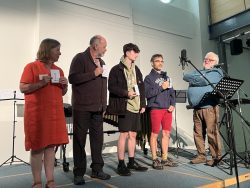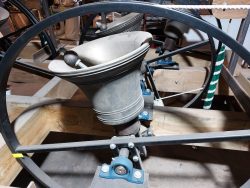 HUMAN beings have been ringing bells for around five millennia – and this ancient art is still alive and thriving today, from the ringtones on your mobile phone to the great bongs of Big Ben, preceding BBC Radio 4 news.
HUMAN beings have been ringing bells for around five millennia – and this ancient art is still alive and thriving today, from the ringtones on your mobile phone to the great bongs of Big Ben, preceding BBC Radio 4 news.
If you are lucky enough to live near a church with a set of bells – and ringers to ring them – you will recognise the different sounds and understand how they can communicate joy, warnings and tolling for funerals to their local communities for centuries.
This year’s Frome Festival has been celebrating bells, bell-ringing and bell-founding, with a 10-day project, Ring Out, which culminated in an evening of talks and music at Rook Lane Arts. The event included the premiere of Full Circle, by local composer Helen Ottaway of Artmusic.
The oldest known bells were in China, around 3,000BC, said guest speaker David Parfrey, who is the general secretary of the Bath & Wells Diocesan Association of Change Ringers. The use of bells has always been rooted in religion, he explained, including Shintoism, Buddhism, Hinduism and Christianity.
Bells have been rung in churches since around 400AD, and have been hung and rung in church towers since a decree by St Dunstan, the Somerset-born Archbishop of Canterbury, around 1000AD. Bell-ringing as we now know it mainly dates from the time of King Charles I and the first books on the art were published later in the 17th century.
 Fabian Stedman published Tintinnalogia in 1668, with Richard Duckworth, and Campanalogia in 1677. He was a leading figure in method ringing, and is remembered in the names of various peals, including Stedman Doubles and Stedman Caters.
Fabian Stedman published Tintinnalogia in 1668, with Richard Duckworth, and Campanalogia in 1677. He was a leading figure in method ringing, and is remembered in the names of various peals, including Stedman Doubles and Stedman Caters.
Frome has its own place in the history of bell-ringing as the base for the famous firm of Cockey & Son, which made bells for dozens of church towers in Somerset, Dorset and Wiltshire.
Helen Ottaway’s new composition, Full Circle, scored for recordings of church tower bells, and violin, clarinet, flugel horn and marimba. Full circle ringing is a technique of ringing a tower bell such that it swings in a complete circle from mouth upwards to mouth upwards and then back again …
The work has a mesmeric quality, reflecting the range of emotions that can be conveyed by bells, with a middle passage that sounded almost Balkan in its poignant, yearning tones, emphasised by the haunting sounds of the clarinet. The sense of coming “full circle” was completed by a return to the recorded tower bells which began the piece.
The musicians were Arabella Thornton, violin, Julie Britton, clarinet, John Plaxton, flugel horn and marimba, Jesse Angeloro, with Helen Ottaway “playing” the tower bells.
Pictured: As part of Ring Out, festival-goers were able to visit Matthew Higby’s bell foundry; bell-ringer David Parfrey (right) with Helen Ottaway (left) and three volunteers, demonstrating a simple four-part ringing pattern.